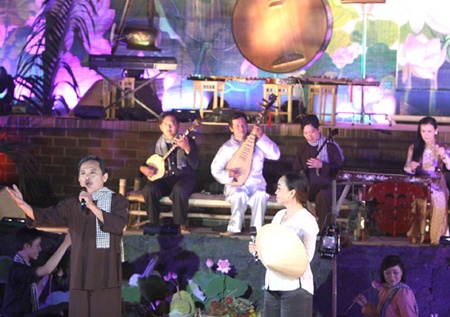
Prime Minister Nguyen Tan Dung said yesterday that preservation of traditional music forms assumes greater importance as the country deepens its international integration.
Prime Minister Nguyen Tan Dung said yesterday that preservation of traditional music forms assumes greater importance as the country deepens its international integration.
 |
| On song: Artists perform tai tu music at the ceremony marking its recognition as a world heritage. |
Every Vietnamese citizen should contribute to this important task, he said at a ceremony held in HCM City last night to mark recognition of tai tu music as an Intangible Cultural Heritage of Humanity by UNESCO.
The event was attended by leaders and artists of 21 provinces and cities that are home to tai tu music.
Dung requested the officials and artisans to implement with enthusiasm and a sense of responsibly the national action programme to preserve and develop the music form that developed in the southern region.
Reiterating that the preservation and development of "cultural values created by our ancestors" was imperative in the context of Viet Nam's international integration, the PM expressed his appreciation for Vietnamese living at home and abroad for their contributions to preserving traditional art forms.
The international recognition that tai tu music has gained is a matter of honour for the people of Viet Nam, he said.
At the ceremony, Katherine Muller-Marin, UNESCO Representative in Viet Nam, handed the certificate to Hoang Tuan Anh, the Minister of Culture, Sports and Tourism.
She said tai tu music has helped bring people closer together and was an essential part of life of Vietnamese living in the southern region.
Tai tu, which originated in the 19th century, carried influences from the court music of Hue as well as folk music traditions in the southern region.
Handed down orally through many generations, the music is typically performed at festivals, death anniversary rituals and celebrations by farmer-artists.
The application for UNESCO recognition was submitted to UNESCO in 2007, and a host of promotion activities were held in the southern provinces to increase the chances of approval.
Though the art form revolves around 20 principal songs and 72 classical songs, don ca tai tu instrumentalists and singers express their feelings through improvisation.
A tai tu orchestra is typically made up of young people who are friends or neighbours who get together after work to practice.
Amateur singers are usually accompanied by string and percussion instruments, including dan co (two-stringed fiddle), dan tranh (16-string zither) and dan bau (monochord).
Local officials and artists said that the UNESCO recognition will significantly contribute to exchanges between communities, musicians and researchers, and help raise awareness of the importance of preserving the nation's heritage.
Tai tu music is the sixth Vietnamese art form to win UNESCO recognition as an Intangible Cultural Heritage of Humanity. The other art forms are: Worship of Hung Kings in Phu Tho Province (2012); the Giong festival of Phu Dong and Soc temples in Gia Lam District, Ha Noi (2010); quan ho singing in Bac Ninh Province (2009); nha nhac (Vietnamese court music) in Hue imperial city; and gong culture in the Central Highlands region (2008).
(Source: VNS)




